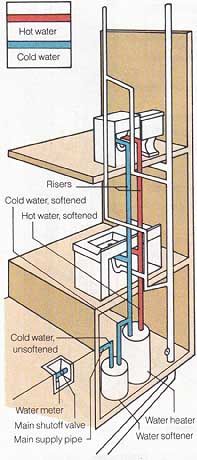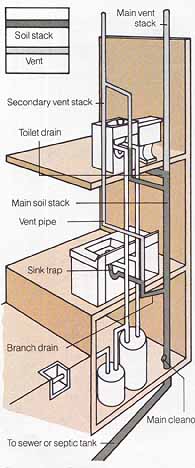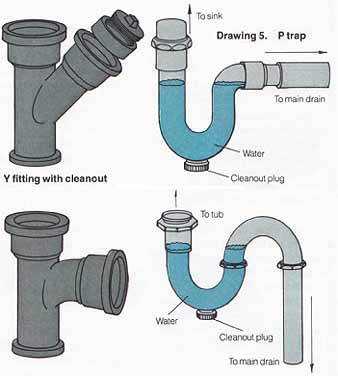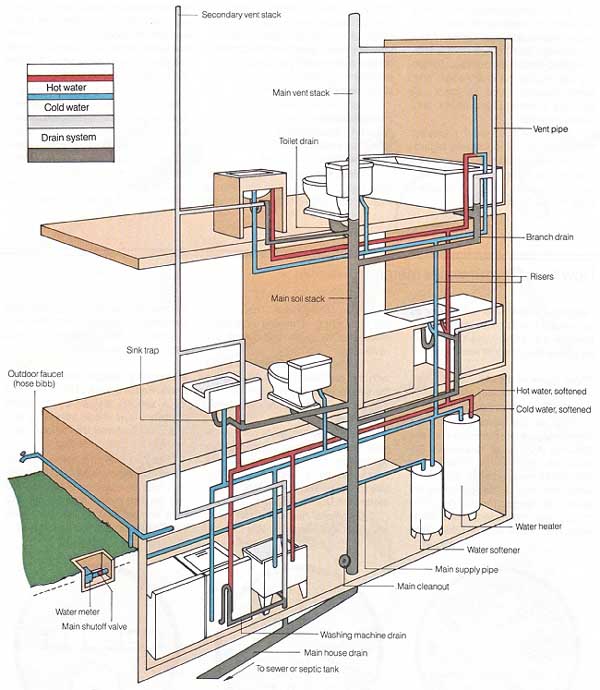If your plumbing experience has been limited to turning a faucet on and off, you’ll be surprised at the simplicity of the system of pipes behind that faucet. Actually, there are three systems: supply, drain-waste, and vent. Before you begin any plumbing project, large or small, it’s a good idea to be familiar with these systems. Once you under stand how plumbing works, you’ll find that making repairs or adding fixtures is simply a series of logical connections.
The supply system carries water from underground water mains, a storage tank, or a well into your house and around to all the fixtures (sinks, showers, toilets) and to such appliances as the washing machine and dishwasher.
The drain-waste system carries used water and waste out of the house into a sewer or a septic tank. The vent system carries away sewer gases and maintains atmospheric pressure inside the drainpipes, preventing deadly gases from entering your home.
The supply system
If you get your water from a water company, it’s probably delivered by underground water main through a water meter and a main shutoff valve. You’ll find the meter either in your basement or crawl space (to guard against freezing in cold-winter areas) or outdoors, near your property line. The main shutoff valve—which turns the water for the whole house on and off—is usually situated near the water meter.
If your water is provided by a water company but is not metered, the main shutoff valve is likely to be at your property line; if you can’t locate it, check with the water company. Where water comes from a private well, the shutoff valve is usually located where the water supply line enters the house, or at the wellhead—or both.
As a rule, the water supply pipe that enters the house is a 1-inch-diameter pipe that’s under about 50 pounds of pressure per square inch (psi), though pressures vary in different localities. (For a discussion of water pressure problems, see our article.)
If the water in your house is softened or filtered, the treatment units will be attached near the point where the water enters the house. Usually, a water softener is placed on a branch pipe that goes to the water heater, so that only the hot water used for laundry or bathing is softened. Chemical injectors or filters will be on the main pipe in the basement or crawl space.
Once inside the house, the supply pipe branches out into pipes of smaller diameters to deliver water to all fixtures and water-using appliances. A separate horizontal pipe makes a stop at the water heater, then runs parallel to the cold water pipes to the kitchen, laundry, and bathrooms throughout the house (see Ill. 1).

Ill. 1. Supply system
Hot and cold water pipes are usually ¾-inch in diameter. Branches that feed the fixtures are generally ½-inch galvanized iron, copper, or plastic pipe. Local codes, practices, and the age of your house will affect the kinds of pipe and fittings you’ll find and will determine what you can use if you’re planning any changes or additions (see Pipefitting Know-how”).
Pipes that run vertically from one floor to the next are called risers. Long risers are often supported at their bases by platforms and anchored to wall studs. Horizontal pipe runs are generally secured to floor joists.
Supply pipes are installed with a slight pitch in the runs, sloping back toward the lowest point in the system so that all pipes can be drained. Sometimes at the lowest point there’s a valve that can be opened to drain the system.
Shutting off the water supply. Most fixtures and water-using appliances have their own shutoff valves to enable you to work at one place without cut ting off the water supply for the entire house. To be prepared for an emergency, everyone in the household should learn how to turn off the water supply, both at individual fixtures and at the main shutoff valve.
Gas and heating system pipes. If you’re planning to do a plumbing job yourself, you must be able to distinguish the water supply pipes from pipes that carry natural gas or pro pane into your home for a gas stove, dryer, or water heater. A gas pipe is usually a black or galvanized pipe that runs from the gas meter directly to a gas appliance or heating system. A separate shutoff valve for emergencies is required on each supply pipe. Don’t try to work on gas piping — call a professional.
Heating system pipes demand equal caution. To locate your heating pipes (hot water or steam), trace them between each heating outlet and the furnace or other heat source. And by all means, leave repairs to an expert.
The drain-waste system
Unlike the supply system, which brings in water under pressure, the drain- waste system gets rid of water and wastes by the force of gravity. These pipes lead away from all fixtures at a carefully calculated slope. If the slope is too steep, water will run off too fast, leaving particles behind; if it’s not steep enough, water and waste will drain too slowly and may back up into the fixture. The normal pitch is ¼ inch for every horizontal foot of pipe.
The workhorse in the drain-waste system is the soil stack, a vertical section of 3 or 4-inch-diameter pipe that carries waste away from toilets (and often from other fixtures) and connects with the main house drain in the basement or crawlspace. From here, the wastes flow to a sewer or septic tank (see Ill. 2).
Since any system will clog occasionally, cleanouts are placed in the drainpipes. Ideally, there should be one cleanout in each horizontal section of drainpipe, plus an outdoor cleanout to give access to the sewer or septic tank. A cleanout is usually a 45° Y fitting (see Ill. 3) or 90° T fitting (see Ill. 4), that makes it possible for a snake or auger to be inserted into the main drainpipe to clear away obstructions.

Ill. 2: Drain-waste and vent (DWV) systems

Ill. 3. Y fitting with cleanout insert; Ill. 4. T fitting;
Ill. 5. P-trap: Cleanout plug; Ill. 6. Strap
The vent system
To prevent dangerous sewer gases from entering the home, each fixture must have a trap in its drainpipe and must be vented. A trap is a bend of pipe that remains filled with water at all times to keep gases from coming up the drains. The two main types are P traps (see Ill. 5) and , in older homes, S traps (see Ill. 6); the latter are no longer allowed by many plumbing codes.
The vents in the drain-waste sys tem are designed to get rid of sewer gas and to prevent pressure buildups in the pipes. The vents come off the drainpipes downstream from the traps and go out through the roof (see Ill. 2). This maintains atmospheric pressure in the pipes and prevents siphoning of water from the traps.
Each plumbing fixture in the house must be vented. Usually, a house has a 4-inch-diameter main vent stack with 1½- to 2-inch vent pipes connecting to it. In many homes—especially single story homes—widely separated fixtures make it impractical to use a single main vent stack. In this situation, each fixture or fixture group has its own waste connection and its own secondary vent stack.
A Typical Plumbing System

Three separate but interdependent systems — supply, drain-waste, and vent — make up a typical plumbing system. Here’s a behind-the-scenes
look at each. The supply system brings water (under pressure) to your house,
through a water meter (if you have one) and a main shutoff valve. The supply
pipes branch off to all fixtures and water-using appliances inside and to faucets outside the house. The drain-waste system carries used water and waste out of the house (with the help of gravity) via the main soil
stack to the sewer or septic tank. The vent system gets rid of sewer gases
for each fixture and maintains proper pressure inside the drain-pipes.
Secondary vent stack; Main vent stack; Branch drain; Risers; Water heater; Water softener; Main cleanout; Washing machine drain; Main house drain; Water meter; Main shutoff valve; Main soil stack; Hot water; Cold water; Drain system